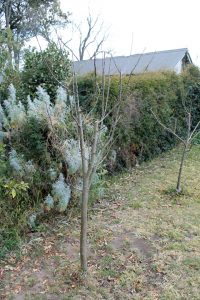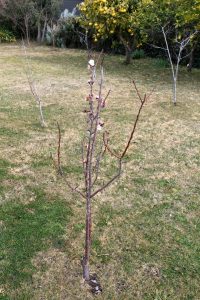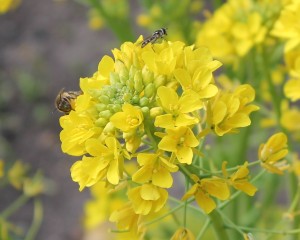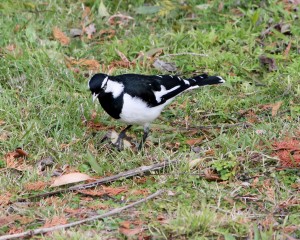I did manage to get out and do some heavy pruning of the fruit trees. The orchard is quite tiny, and I have probably placed the trees too close together, so I have been trying my best to keep them under control (semi-bonsai’ed, as it were). The apple, cherry and pear trees had sent up some solid leaders that I guess I should have cut earlier. They were all 3 to 5cm in diameter, so I cut them at the closest branching sections to belly button height (my belly button being easier to carry around than a tape measure). I then said sorry, gave them a good watering, and crossed my fingers that they would survive the ordeal. I’m pretty sure they’ll be fine, but they are currently doing their best to look dejected and vandalised.
One half of the dual variety apricot tree has already burst into bloom. Well, more of a whimper into bloom actually, as the flowers only seem to last a couple of days before the frost or the chilled gusting winds kill them off. As a result, the buds and the dead brown blooms vastly outnumber the few pretty pink flowers. Fortunately I’ve spotted at least a couple of bees making a visit for the minimal pollen that’s on offer.
Speaking of bees and flowers, the cime di rapa have all burst into bright yellow blooms and have attracted quite a fan club. There are usually a few bees to be seen, plus some yellow butterflies, but mostly what I had thought were native bees, but have now realised are the less wholesome sounding hoverflies (which are apparently good for the garden, and look bee-like in the hind quarters, but their eyes are too similar to their nasty relatives for me to feel too good about them – it’s like having a hoard of Jeff Goldblums climbing all over our food).
Last month we had an outing to the Royal Botanic Gardens in Sydney, and managed to take a few inspirational photos (here). I was also rather pleased with the Events Calendar I added to this website some weeks back (here). And that’s pretty much been it for Our Highland Garden for the winter of 2014. Both the garden and I are now impatiently awaiting the starting gun for Spring…






